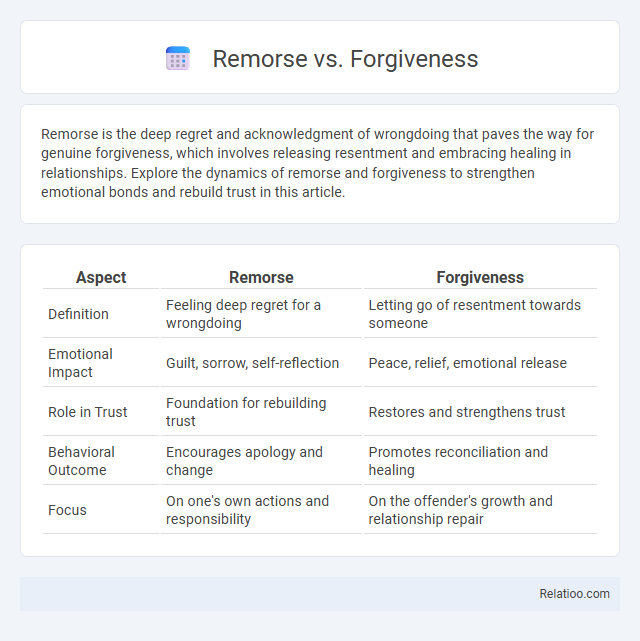Remorse is the deep regret and acknowledgment of wrongdoing that paves the way for genuine forgiveness, which involves releasing resentment and embracing healing in relationships. Explore the dynamics of remorse and forgiveness to strengthen emotional bonds and rebuild trust in this article.
Table of Comparison
| Aspect | Remorse | Forgiveness |
|---|---|---|
| Definition | Feeling deep regret for a wrongdoing | Letting go of resentment towards someone |
| Emotional Impact | Guilt, sorrow, self-reflection | Peace, relief, emotional release |
| Role in Trust | Foundation for rebuilding trust | Restores and strengthens trust |
| Behavioral Outcome | Encourages apology and change | Promotes reconciliation and healing |
| Focus | On one's own actions and responsibility | On the offender's growth and relationship repair |
Understanding Remorse: Defining Genuine Regret
Genuine remorse involves deeply recognizing and feeling regret for causing harm, reflecting an honest self-awareness and accountability. Unlike forgiveness, which is an external act of letting go by the offended party, remorse is an internal emotional response that motivates change and repair. Understanding remorse is crucial for authentic personal growth and rebuilding trust in damaged relationships.
The Psychology Behind Forgiveness
The psychology behind forgiveness reveals its crucial role in emotional healing by reducing anger and promoting empathy toward others. Forgiveness is linked to decreased stress levels and improved mental health, distinguishing it from remorse, which involves self-reproach and guilt for causing harm. Understanding the interplay between remorse and forgiveness aids psychological interventions designed to foster reconciliation and personal growth.
Remorse vs Forgiveness: Key Differences
Remorse is an intense feeling of guilt or regret for a wrongdoing, reflecting personal acknowledgment of harm caused, while forgiveness is the act of pardoning someone for their offense, often facilitating emotional healing and reconciliation. Remorse arises internally, driving the individual toward self-reflection and change, whereas forgiveness is extended externally, typically by the person who was wronged or by oneself. Understanding the distinction between remorse as a personal emotional response and forgiveness as a relational or interpersonal process is crucial in resolving conflicts and fostering psychological well-being.
The Role of Empathy in Healing
Empathy plays a crucial role in the healing process by allowing individuals to understand and share the feelings of others, facilitating genuine remorse and fostering forgiveness. When remorse is expressed with empathetic understanding, it validates the emotional pain caused, creating a foundation for reconciliation. Forgiveness arises more readily when empathy bridges the emotional gap, promoting emotional healing and restoring relationships.
How Remorse Initiates the Path to Forgiveness
Remorse triggers a deep emotional realization of wrongdoing, compelling you to acknowledge the harm caused and take responsibility. This sincere regret lays the groundwork for forgiveness by opening a channel for empathy and reconciliation. Forgiveness, in turn, restores trust and promotes healing by allowing both parties to move beyond past mistakes.
Barriers to Expressing Remorse
Barriers to expressing remorse often include fear of vulnerability, perceived loss of power, and cultural norms that discourage emotional openness. You might also struggle with acknowledging mistakes due to guilt, shame, or defensiveness, which impede genuine apology and reconciliation. Overcoming these obstacles is essential for fostering forgiveness and rebuilding trust in relationships.
The Benefits of Granting Forgiveness
Granting forgiveness promotes emotional healing by reducing stress and fostering psychological well-being. It breaks the cycle of resentment, allowing individuals to move past hurt and build healthier relationships. Forgiveness enhances empathy and compassion, contributing to personal growth and improved mental health.
Steps to Cultivate Forgiveness After Hurt
Cultivating forgiveness after hurt involves acknowledging the pain, understanding the role of remorse from the offender, and consciously choosing to release resentment. Psychological research emphasizes empathy development as a crucial step, allowing individuals to see the situation from the offender's perspective, which facilitates emotional healing. Practicing mindfulness and self-compassion further strengthens the capacity to forgive, leading to improved mental health and restored relationships.
Forgiveness Without Remorse: Is It Possible?
Forgiveness without remorse can occur when the forgiver chooses to release resentment despite the offender's lack of guilt or apology, prioritizing their own emotional healing over the offender's accountability. Psychological research shows that such forgiveness often involves setting personal boundaries and practicing empathy without condoning the harmful behavior. This distinction allows individuals to regain peace without necessitating the offender's remorse, highlighting the complex dynamics between forgiveness and emotional recovery.
Building Healthier Relationships Through Remorse and Forgiveness
Remorse and forgiveness play crucial roles in building healthier relationships by fostering emotional healing and trust restoration. Genuine remorse involves acknowledging mistakes and expressing sincere regret, which opens the door for forgiveness to take place. Forgiveness, in turn, allows both parties to move forward, reducing resentment and promoting mutual understanding essential for long-lasting connections.

Infographic: Remorse vs Forgiveness
 relatioo.com
relatioo.com